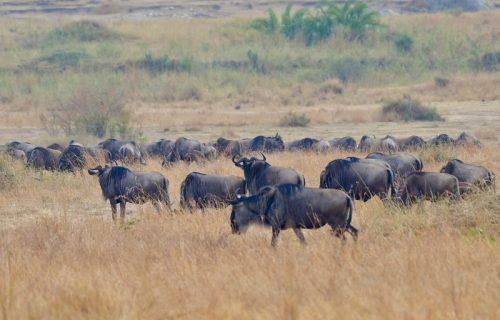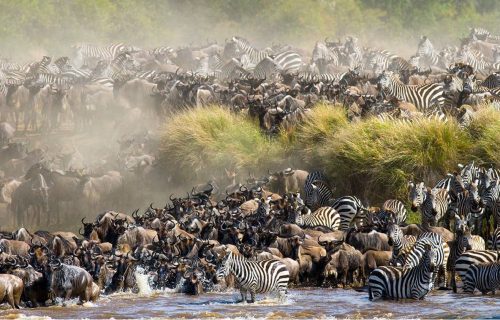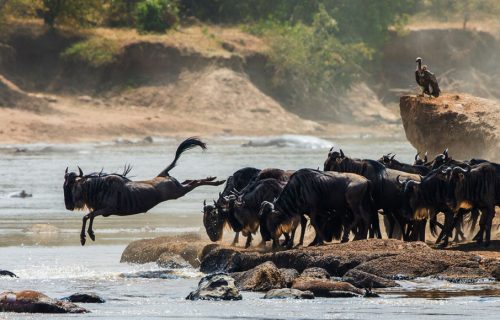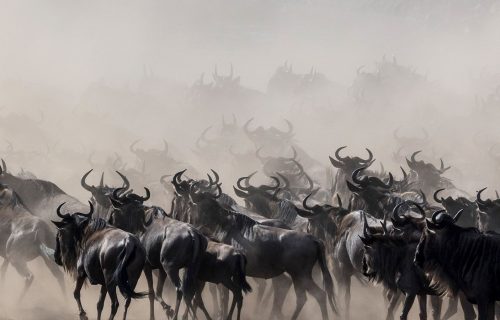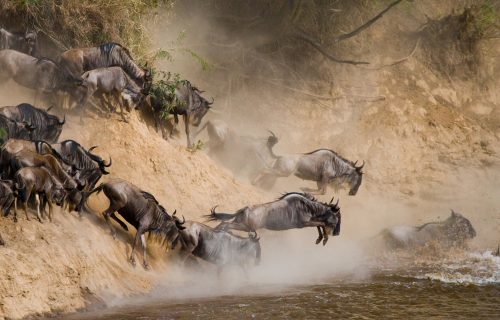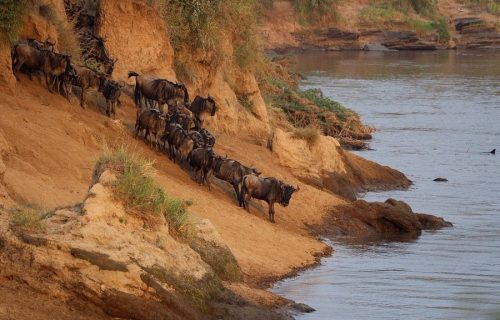The Great Wildebeest Migration 2025, Facts, Map & Distance
Top Secret Guide to Great Wildebeest Migration, Map & Facts: How the Great Migration moves throughout the year, When Is The Best Time To Go On A Migration Safari, Where Are The Best Places To Stay On A Migration Safari, What Are The Best Migration Safari Tours.
Great Wildebeest Migration in Tanzania and Kenya is one of the world’s natural wonders as the herds are the largest that can ever be spotted in the wilderness. Tanzania is one of the planet’s most impressive wildlife events as millions of animals roam through the Tanzania Serengeti and Kenya’s Maasai Mara ecosystem.
The wildebeest migration safari is one of the world’s natural wonders as the herds are the largest that can ever be spotted in the wilderness. Wildebeest (Connochaetes taurinus) is a member of the antelope family and is also known as the gnu. They are identical to having a large, box-like head with curving horns.
The Great Wildebeest Migration Safari in Masai Mara Kenya
The front end of the body is heavily built and the hindquarters are slender with spindly legs. The wildebeest coat is gray with a black mane and a beard either white or black. The specific wildebeest species that forms the large herds of the Serengeti-Mara ecosystem are the white-bearded wildebeest. For where to find the wildebeest all throughout the year, here is a guide on where to see the wildebeest each month of the year either in the Serengeti or Mara.
Great Wildebeest Migration Facts
Various natural occurrences take place globally, although only a handful can rival the immense scale of the yearly Wildebeest Migration across the Serengeti-Mara Ecosystem. The sheer magnitude of the numbers is astounding: as many as 2 million animals, including wildebeest, zebra, and gazelle, embark on a perilous 3,000-kilometer (1,900-mile) journey driven by the rains and their innate instincts.
The migration of the herds is a grand spectacle characterized by immense drama, as they face various difficulties and adversities while transitioning between different regions. These animals are frequently targeted by predators, particularly Africa’s large felines such as lions, leopards, and cheetahs, as well as the enormous crocodiles that ambush them at several river crossing locations.
Tips For Planning Your Great Wildebeest Migration Safari
- Book early: At a minimum, one should plan at least one year in advance. Accommodations at lodges and camps are quickly occupied, particularly during the period from June to October, which is ideal for a Great Migration safari. Keep in mind that this is the peak season for safaris and when the well-known river crossings occur. However, you can observe the herds at any time during the year.
- Arrange your timing carefully: The Migration is a continuous journey that occurs throughout the year, and certain sections of the journey, like as river crossings, are unpredictable. The optimal timing for embarking on a Wildebeest Migration safari is contingent upon your desired sightings and experiences.
- Go private: The national parks have significant levels of congestion during the peak safari season, which spans from June to October. If you desire both exclusivity and easy access to the herds, it is advisable to lodge in a private reserve or conservancy.
Peruse the Wildebeest Migration safaris we suggest below, or contact one of our Africa Safari Specialists to assist you in customizing an itinerary that aligns with your travel preferences:
Best Great Wildebeest Migration Tours & Safaris
2 Days Serengeti Safari Itinerary
2 Days Serengeti Safari Tanzania is designed for travelers to Tanzania with limited time but still want to traverse the expansive Serengeti Park.
3 Days Masai Mara Safari Itinerary
3 Days Masai Mara safari /3 days 2 nights Masai Mara safari is a guided safari from Nairobi on a budget or luxury package for 3 days and 2 nights.
9 Days Camping Tanzania Safari
9 Days Tanzania camping safari is all about catching the big five in their natural habitats. 9 Days Budget camping safari Tanzania
3 Days Serengeti Migration Safari
3 Day luxury Serengeti Migration Safari in Serengeti National Park Travelers on business or those with limited time who want to see the huge wildebeest migration.
Masai Mara And Serengeti Safari
8 Days Masai Mara and Serengeti Safari puts you in the middle of the largest terrestrial animal migration in the world and allows you to experience two of Kenya and Tanzania.
Wildebeest Crossing Mara River
4 Days watching the Great Wildebeest Migration Crossing Mara River, this 4 days trips takes to see the big Wildebeest Migration of herds along the banks of the Mara River.
Choosing the Right Great Migration Africa Itinerary
At Kabira Safaris & Tours Africa, we acknowledge the individuality of every traveler. Therefore, our Great Migration Africa itineraries are meticulously customized to align with your specific tastes. We take into account the scheduling of your safari, the specific highlights you desire, your preferred level of adventure, and the type of lodging that aligns with your own style.
If you are enthusiastic about capturing the impressive river crossings on camera or if you desire to observe the spectacle from a hot air balloon, we will assist in creating the ideal schedule for you.
The Great Wildebeest Migration Map Tracker
- Where is the Wildebeest Migration in January?
- Where is the Wildebeest in February?
- Where can I see the wildebeest in March?
- Where is the wildebeest migration in April?
- Where can I see the wildebeest in May?
- Where to see the wildebeest in June?
- Where is the wildebeest in July?
- Where to see the Wildebeest in August September?
- Where are the wildebeest in October?
- Where to see the wildebeest in November?
- Where can I see the wildebeest migrate in December?
- When do the wildebeest cross the Mara River?
Wildebeest Migration Map, Route & Tracker
The Great Wildebeest Migration is a continuous, circular migration of over a million animals across the Serengeti-Mara environment, and it is one of the most sought-after events for wildlife and nature aficionados. Wildebeest and their many traveling buddies travel in seemingly endless columns down a well-worn path in search of pasture and water. The animals leave the Serengeti in the south of Tanzania, near the Ngorongoro Conservation Area, to travel clockwise via the Serengeti to the Masai Mara in Kenya, and then return to the Serengeti in the late fall. As thousands of animals are killed by predators and thousands more are created, maintaining the balance of nature, great drama is guaranteed at every turn.
Where is the Wildebeest Migration in January?
In January, the wildebeest herds are comfortably settled in Southern Serengeti, close to the Lake Ndutu region and the Ngorongoro Conservation Area of Tanzania.
There is enough food for them here for the next few months because of the short rains in the past November and December. During this time the calving season begins.
Where is the Wildebeest in February?
Serengeti, Tanzania is where you can find the wildebeest in February.
From end of January to February, the calving season usually begins taking a period of over 2-3 weeks as thousands of wildebeest, zebra and gazelle give birth to their young ones.
Approximately 500,000 calves are born in this period, often seen prancing around near their mothers. The predators are never too far behind either, eager for an easy kill. Expect to see lots of lions, cheetah, leopards, and hyenas nearby. Depending on the rains, the herds may move around somewhat, staying mostly in the Ndutu region of the Ngorongoro Conservation Area towards Southern Serengeti.
Where can I see the wildebeest in March?
By March the wildebeest are still in southern Serengeti, Tanzania? This time is also the best time to visit Serengeti migration as it is the low season and pricing is usually low.
By this time, the calving season has also just ended and therefore you see the large herds with the calves still young enough to be amusing to watch. The rains start from mid-march onwards.
Where is the wildebeest migration in April?
By April, the rainy season is on and the wildebeest herds with calves are in Serengeti, Tanzania.
This is the long rain season in both Kenya and Tanzania. Expect heavy thundershowers and muddy roads. The herds are in still in Southern and Eastern Serengeti.
It’s a low season and pricing is low as well with several camps shut down during this period.
Where can I see the wildebeest in May?
May is the transition season as the herds start to move north heading ultimately for the Mara River.
By May the wildebeest are usually seen moving into Central Serengeti (Moru kopjes and central Seronera Valley), but depending on the rains, we may also see herds further south still, or approaching the western corridor.
Where to see the wildebeest in June
In June the herds are in Serengeti and heading to the Mara River, it is a very unpredictable month.
The herds should normally be heading to the Western Corridor into the private Grumeti Reserves.
Due to varying weather patterns, the herds may split and be spread across Central, Eastern, and Western Serengeti. If it is a very dry year with less pasture, the herds usually head north towards the Mara River at this time.
Since the herds may be very much spread out during this time it is advisable to stay in different parts of the park to increase the chances of spotting.
Where is the wildebeest in July?
By mid to end July, the migration usually arrives in Northern Serengeti near Kogatende and may or may not cross the Mara River and international border into Kenya.
This again is completely dependent on weather patterns. If there is plenty of food in the Serengeti, the herds may linger around for longer and head north only by end July / early August.
If it is a dry year, they most likely will head towards the Mara River by early July.
This is the time period of the dramatic Mara River crossings as herds cross back and forth the treacherous croc-infested Mara River. The Mara river crossing is a dramatic event that is great to experience in the annual wildebeest migration cycle.
Where to see the Wildebeest in August & September
All through August and September, the wildebeest are in Kenya.
These are usually the best months of the year to see the wildebeest migration from the Kenya side of the border in the Masai Mara Game Reserve.
For those patient enough, the chances of catching a dramatic river crossing are also quite high.
This is also one of the best times to visit Northern Serengeti. Remember, the Serengeti and Masai Mara are a continuation of the same eco-system, simply divided by an international border.
Where are the wildebeest in October?
By early to mid-October, the herds usually head back to the Serengeti from the Masai Mara.
Very often we find that if it rains on either side of the border, the herds may cross to and fro, depending on where they find new grass.
If you were to hedge your bets, it would make more sense to plan a Tanzania safari during this month.
Where to see the wildebeest in November
By this time, the wildebeest are now in Serengeti, Tanzania. November is the month of short rains in East Africa.
With the rains comes new grass and the herds begin to move South.
Again, it is very hard to predict where the herds will be during this month; they can be as far South as Ndutu or they can remain North. Often, the herds split and take different routes.
Central Serengeti is probably your best bet to catch the herds. It’s a great base to go in whichever direction the herds may be.
Visiting both the south and north increases the chance to see more of the wildebeest drama.
Where can I see the wildebeest migrate in December?
By December the wildebeest are usually around Central Serengeti, heading South and East towards Ndutu and the Ngorongoro Conservation Area to settle in before the calving season begins.
There is plenty of fresh grass here for the next few months, especially for their hungry young calves.
When do the wildebeest cross the Mara River in Kenya?
The Great Wildebeest Migration Safari from the Serengeti to the Maasai Mara, Crossing Mara River
One of the most dramatic moments is when the wildebeest cross the Mara River, it’s such a spectacle as the wildebeest herds cross through the crocodile-infested waters in order to move to where they can find pasture as dictated by the rains. The Kenya Great migration river crossing occurs from July to October.
With the wildebeest migration safari for each month explained, you can plan your African wildebeest migration safari in Africa according to what you want to experience.


